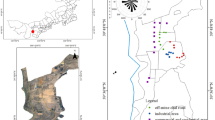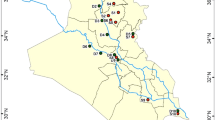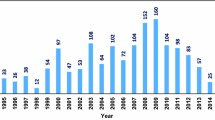Abstract
The mineralogy characterization of dust fall in atmosphere is important in understanding and improving air quality. In this paper, dust fall samples were collected in the suburb of four areas of northwest China during April to May 2012. The size distribution, mineral phase and composition, morphology, and surface charge of dust fall were investigated, respectively, by particle size analyzer, X-ray powder diffraction spectrometer (XRD), scanning electron microscopy (SEM), and zeta potential analyzer. The average volume size of dust fall was from 59.17 to 62.88 μm, and the dust fall in Tuoketuo County of Inner Mongolia Autonomous Region had the finest particles (59.17 μm), while the number percentage of fine particulate matter (<1.0 μm) in dusts was about 88.36 % of total particles. The main minerals of dust fall samples are composed of quartz, calcilte, muscotive, albite, clinochlore, and gypsum. And four dust fall samples had the same main mineral phase. Minerals of surface soil were identified as an important source of atmospheric dust fall. The morphological of the atmospheric dust fall presented irregular square, sphere, agglomerate elongated particles, and granular aggregates. Zeta potentials of four dust fall samples were negative in tested pH range. Moreover, their zeta potentials decreased with increasing pH of the solution. The surface charge of dust fall was strongly affected by the quantity of carbonate minerals (calcite and dolomite) in samples. The simulated zeta potential result of multimineral dusts indicated that the magnitude and tendencies of dust’s zeta potential were dominated by the main mineral phase in dust fall.






Similar content being viewed by others
References
Abed AM, Kuisi MA, Khair HA (2009) Characterization of the Khamaseen (spring) dust in Jordan. Atmos Environ 43(18):2868–2876
Asati A, Santra S, Kaittanis C, Perez JM (2010) Surface-charge-dependent cell localization and cytotoxicity of cerium oxide nanoparticles. ACS Nano 4(9):5321–5331
Belozerova OY (2009) Investigation of soil mineral component in the Baikal Region by X-ray electron probe microanalysis. Spectrochim Acta B 64(11–12):1248–1252
Berube KA, Jones TP, Williamson BJ et al (1999) Physicochemical characterisation of diesel exhaust particles: factors for assessing biological activity. Atmos Environ 33(10):1599–1614
Buseck PR, Posfai M (1999) Airborne minerals and related aerosol particles: effects on climate and the environment. Proc Natl Acad Sci USA 96(7):3372–3379
Cho H, Oh D, Kim K (2005) A study on removal characteristics of heavy metals from aqueous solution by fly ash. J Hazard Mater 127(1–3):187–195
Cho WS, Duffin R, Thielbeer F et al (2012) Zeta potential and solubility to toxic ions as mechanisms of lung inflammation caused by metal/metal oxide Nanoparticles. Toxicol Sci 126(2):469–477
Davis BL, Guo JX (2000) Airborne particulate study in five cities of China. Atmos Environ 34(17):2703–2711
Donahue NM, Robinson AL, Pandis SN (2009) Atmospheric organic particulate matter: from smoke to secondary organic aerosol. Atmos Environ 43(1):94–106
Dong FQ, He XC, Li GW (2005) Study on the basic characteristics of several atmospheric dusts in the norther china. J Min Pet 25(3):114–117
Dordevic D, Mihajlidi-Zelic A, Relic D (2005) Differentiation of the contribution of local resuspension from that of regional and remote sources on trace elements content in the atmospheric aerosol in the Mediterranean area. Atmos Environ 39(34):6271–6281
Feng JL, Zhu LP, Ju JT et al (2008) Heavy dust fall in Beijing, on April 16–17, 2006: geochemical properties and indications of the dust provenance. Geochem J 42(2):221–236
Florig HK, Sun GD, Song GJ (2002) Evolution of particulate regulation in China–prospects and challenges of exposure based control. Chemosphere 49(9):1163–1174
Goodarzi F (2006) Morphology and chemistry of fine particles emitted from a Canadian coal-fired power plant. Fuel 85(3):273–280
Gulgonul I, Karaguzel C, Celik MS (2008) Surface vs. bulk analyses of various feldspars and their significance to flotation. Int J Miner Process 86(1–4):68–74
Kaegi R (2004) Chemical and morphological analysis of airborne particles at a tunnel construction site. J Aerosol Sci 35(5):621–632
Maslova MV, Gerasimova LG, Forsling W (2004) Surface properties of cleaved mica. Colloid J 66(3):322–328
McGuinnes C, Duffin R, Brown S et al (2011) Surface derivatization state of polystyrene latex nanoparticles determines both their potency and their mechanism of causing human platelet. Aggreg In Vitro Toxicol Sci 119(2):359–368
Menon S, Hansen J, Nazarenko L, Luo YF (2002) Climate effects of black carbon aerosols in China and India. Science 297(5590):2250–2253
Moreno T, Jones TP, Richards RJ (2004) Characterisation of aerosol particulate matter from urban and industrial environments: examples from Cardiff and Port Talbot, South Wales, UK. Sci Total Environ 334–335(1):337–346
Oanh KNT, Upadhyaya N, Zhuang YH et al (2006) Particulate air pollution in six Asian cities: spatial and temporal distributions, and associated sources. Atmos Environ 40(18):3367–3880
Pope CA III, Burnett RT, Thurston GD et al (2004) Cardiovascular mortality and long-term exposure to particulate air pollution: epidemiological evidence of general pathophysiological pathways of disease. Circulation 109(3):71–77
Qi BC, Aldrich C (2008) Biosorption of heavy metals from aqueous solutions with tobacco dust. Bioresour Technol 99(13):5595–5601
Rodriguez K, Araujo M (2006) Temperature and pressure effects on zeta potential values of reservoir minerals. J Colloid Interface Sci 300(2):788–794
Vdovic N, Biscan J (1998) Electrokinetics of natural and synthetic calcite suspensions. Colloid Surf A 137(1–3):7–14
Vento SD, Dachs J (2007) Atmospheric occurrence and deposition of polycyclic aromatic hydrocarbons in the northeast tropical and subtropical Atlantic ocean. Environ Sci Technol 41(16):5608–5613
Veronesi B, Haar CD, Lee L, Oortgiesen M (2002) The surface charge of visible particulate matter predicts biological activation in human bronchial epithelial cells. Toxicol Appl Pharmacol 178(3):144–154
Wang B, Li K, Jin WJ et al (2013a) Properties and inflammatory effects of various size fractions of ambient particulate matter from Beijing on A549 and J774A.1 cells. Environ Sci Technol 47(18):10583–10590
Wang M, Deng YQ, Dong FQ et al (2013b) Speciation analysis of cadmium in dust fall about northern China towns. Asian J Chem 25(13):7522–7526
Zhang RJ, Han ZW, Cheng TT, Tao J (2009) Chemical properties and origin of dust aerosols in Beijing during springtime. China Particuology 7(1):61–67
Zhao JP, Peng PA, Song JZ, Ma SX, Sheng GY, Fu JM (2010) Research on flux of dry atmospheric falling dust and its characterization in a subtropical city, Guangzhou, South China. Air Qual Atmos Health 3(3):139–147
Acknowledgments
This work was supported by the National Natural Science Foundation of China (No. 41130746).
Author information
Authors and Affiliations
Corresponding author
Additional information
Editorial handling: H. Hongping
Rights and permissions
About this article
Cite this article
Dong, FQ., Chen, W., Dai, QW. et al. Characterization of mineralogy and surface zeta potential of atmospheric dust fall in northwest China. Miner Petrol 109, 387–395 (2015). https://doi.org/10.1007/s00710-014-0347-1
Received:
Accepted:
Published:
Issue Date:
DOI: https://doi.org/10.1007/s00710-014-0347-1




